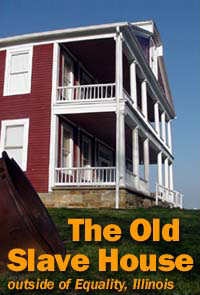 HICKORY HILL — The cornerstone for John Hart Crenshaw's manor house is dated 1838. Located outside Equality, Illinois, the Old Slave House, as it's better known, has long been the focus of stories of slavery associated the third floor. According to research conducted in the 1930s, even the ghost stories were in circulation as far back as 1851. Jon Musgrave photo |
|
So what do you think? Sign the Guestbook View the Guestbook
 |
|
Old Slave House Public meeting set for Thursday
MARION (June 9, 2003) — A public meeting will be held at 6:30 p.m. Thursday, June 12, at Southeastern Illinois College in the private dining room off of the cafeteria. The purpose of the meeting will be to develop and endorse a plan of action in an effort to get the Old Slave House reopened to the public. Any person with an interest in the Old Slave House or developing and promoting tourism in southeastern Illinois is welcomed to attend. "So far, we've managed to 'save' the Old Slave House, but getting it reopened is the sore point," explained meeting organizer Jon Musgrave. "Right now we have an agency in charge that has no plans to reopen the site — mainly because they have no funding," said Musgrave. "I can't complain about their position because it's the only appropriate one they can have, but I can offer an alternative. That's what this meeting is about." Musgrave said that if area residents and business owners want to see the site reopened immediately, then they need to say so. Based on its attendance in the 1980s when more than 38,000 visitors a year toured it, Musgrave predicted 60 new jobs could be created when it reopened based on an old formula used by the Bureau of Tourism that predicted 60 new jobs for every 100 additional visitors a day a region could attract. Even if funding magically appeared, the state agency in charge of the site told the head of the Black Legislative Caucus less than two weeks ago that it wouldn't likely reopen this year, or even necessarily the next. "What we are facing now is the danger that the site could be mothballed like the Shawneetown Bank," said Musgrave in reference to the former state Bank of Illinois building in downtown Old Shawneetown purchased as a state memorial in the 1940s and never yet renovated and reopened to the public. "By Springfield's timetable it could take years before the site reopens and the region starts benefiting from the tourist dollars. I say there's another way. If we can agree on a solution we can then present it to the governor," said Musgrave. "Blagojevich told me when he visited John A. Logan College this spring he would support reopening the site. We need to be able to present him with a plan — one by the way that can be done without any costs to the state." The Old Slave House closed to the public in 1996 when the owner retired. The state purchased the property in 2000 and bought the antiques and artifacts associated with the house this spring. Meanwhile, the previous owner has continued to occupy the site as an unpaid guard in an effort to keep vandals away. "Everybody supports reopening the Old Slave House. Our local legislators do, members of the Black Caucus do. All that everyone is waiting for is a plan to do it. We have the support, we now just need to show them what we want," added Musgrave. Thursday's meeting is free and opened to public. Musgrave, along with local historians Ron Nelson and Gary DeNeal, helped document the real history behind the stories of the Old Slave House following site's closure in 1996. So far, the trio have shown that the original owner, John Hart Crenshaw, had been involved in slave trading and the kidnapping of free blacks to sell into slavery, for at least 20 years during which time his built his plantation manor house atop Hickory Hill. For more information on the Old Slave House and for any updates, check out Musgrave's website, www.IllinoisHistory.com. |
|||||||||
